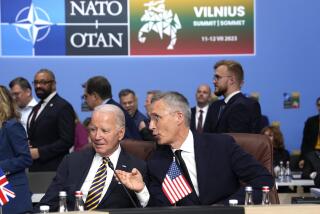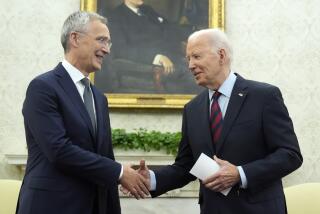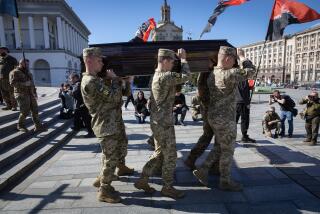Border With Albania Is 3-Way Battleground
KARAULA DEVA, Yugoslavia â A few minutes after the faintest sound of jets was heard, Yugoslav artillery fell silent along the Albanian border. Then the airstrikes began.
The NATO bombings usually donât last more than an hour, though. And as the roar from fighter-bombers trailed off beyond the mountains, the Yugoslav artillery opened up again with a heavy whumpf.
Itâs all part of the three-way game of hide-and-seek by Yugoslav forces, NATO jets and the Kosovo Liberation Army, or KLA, guerrillas who are trying to fight their way across the Albanian border into their homeland.
The battles went on throughout the day here Thursday, the steady thump of artillery and bombs broken by brief interludes when the only sound came from songbirds in a meadow.
The heaviest bombing attacks were concentrated in the area around the Yugoslav village of Morina, just across the border from the Albanian town of Tropoje, which has long been known as one of the KLAâs main bases outside Kosovo.
About seven miles southeast of Morina, here at Karaula Deva, Yugoslav soldiers appeared relaxed and in high spirits at a small hillside border post complete with a satellite television dish, an outdoor basketball court and a small orchard.
Although the soldiers complained that they canât get enough cigarettes, they had such other comforts as fresh-baked bread. More important, there were no obvious signs of any rebel attacks here.
âItâs difficult terrain,â said Sgt. Bosko Cvetkovic, 37, pointing behind the border post to a line of grassy hilltops that reach a height of about 3,000 feet.
âIf they wanted to enter our territory here, they would have to come up over those hills and they would be easy targets,â he said. âTheyâre trying to find some easier terrain.â
The Yugoslav army brought a small group of journalists from Pristina, Kosovoâs capital, to the border post Thursday to disprove recent reports that the KLA had seized the site.
Journalists werenât allowed to get any closer to the border clashes around Morina. But North Atlantic Treaty Organization warplanes--and the smoke rising from their targets--were easy to see in the distance on a clear spring day.
After more than an hour of shelling what were said to be rebel targets along the border, the Yugoslav artillery--which fire four rounds a minute at their peak--fell silent just after noon with the sound of approaching NATO jets.
Within 20 minutes there were several plumes of black smoke rising from Yugoslav villages close to the border and from the outskirts of Djakovica, a nearby town.
Two black NATO warplanes, apparently searching for more targets, circled overhead until about 12:50 p.m., when they flew away. At 1:10 p.m. the Yugoslav artillery gunners were back at work.
It went on like that all afternoon, while children in shanties on the edge of Djakovica played a game of spot-the-NATO-plane. There was no sign that the bombing had Yugoslav forces on the run.
âTheyâre trying to find artillery and armor, but they havenât had any success,â said Vladimir Pejic, 21, a Yugoslav army soldier posted here two months ago.
On the rocky track up to the border post, it was plain to see why NATO pilots might have trouble hitting their intended targets. Troops had one artillery piece hidden in the backyard of a house.
To NATO, that is a despicable use of civilian buildings as military cover. But to Yugoslav soldiers, it is the only way they can fight superior air power and a regrouping guerrilla force at the same time.
When NATO began airstrikes against Yugoslavia on March 24, the allianceâs main aim was to get President Slobodan Milosevic to sign a peace deal for Kosovo that would have put 28,000 peacekeepers in the province, which is part of Yugoslaviaâs dominant republic, Serbia.
During more than five weeks of NATO airstrikes, Yugoslav forces and paramilitary units in Kosovo have emptied vast areas in the province of its ethnic Albanian majority and overrun all seven of the KLAâs regional headquarters.
The only significant fighting on the ground now is along the Kosovo portion of Yugoslaviaâs border with Albania, where both warring sides accuse each other of launching artillery or rocket attacks.
NATO and the Albanian government call Yugoslav troops the aggressors and accuse them of trying to provoke a wider conflict by shelling Albanian territory and even making brief incursions across the border.
Milosevicâs regime insists that its forces are fighting a defensive battle against KLA guerrillas in Albania who want to move fighters and weapons back into Kosovo.
So Yugoslav forces see NATO as the KLAâs air force. Although NATO officials have repeatedly said they donât have any direct links with the guerrillas, the alliance is at least cheering the KLA on from the sidelines.
âLike a phoenix which rises from the ashes, the Kosovo Liberation Army is able to mount a number of attacks still inside Kosovo,â NATO spokesman Jamie Shea told reporters at a daily briefing in Brussels on April 16.
âAnd of course, as NATO depletes the assets of the Serb armed forces, there will be more and more scope for those attacks by the KLA to be stepped up with greater effectiveness,â he said.
But NATOâs air war has proved unable to end the scorched-earth offensive of Yugoslav security and paramilitary forces in the province, and Shea acknowledged several days later that the KLA canât hold on to territory.
The Yugoslav military claims that the separatist guerrillas canât mount significant attacks in the heart of Kosovo, outside two mountain enclaves: in the Jezerske mountain, west of the city of Urosevac in the south; and the Bajgora area, near the northern town of Podujevo.
While NATO pilots tried Thursday to knock out artillery and armor near the Albanian border, they also attacked military vehicles moving along the main highway linking Pristina with the western Kosovo city of Pec.
Heavy NATO bombardment at 2 p.m. and again an hour later devastated the Ferro-Nickel Enterprise factory, near Glogovac.
The factory used to employ about 3,000 people, most of them Kosovo Albanians, but Serbian officials said it was destroyed in Thursdayâs attack, which started a huge fire.
The blaze spewed a dense cloud of black smoke that drifted across the horizon toward Pristina, about 15 miles to the east.
* LOW ON WEAPONS: The air campaign against Yugoslavia is depleting the U.S. stockpile of cruise missiles. A29
More to Read
Sign up for Essential California
The most important California stories and recommendations in your inbox every morning.
You may occasionally receive promotional content from the Los Angeles Times.










